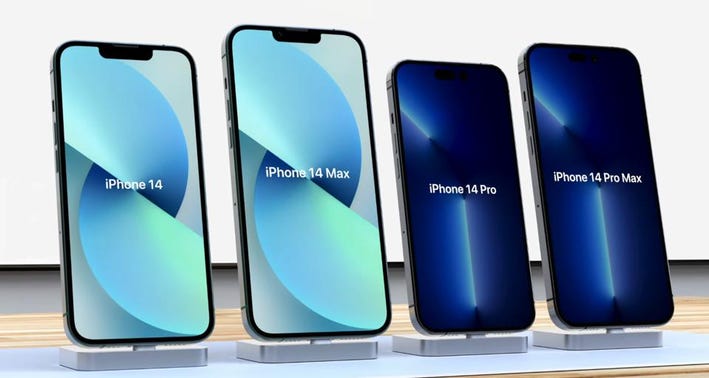New Apple leak reveals iPhone 14 screen shock

According to multiple iPhone 14 leaks, Apple’s new entry-level iPhone will be almost identical to its predecessor. But now momentum is gathering around a surprising upgrade, which has the potential to leave rivals behind.
Speaking to me, respected industry display specialist Ross Young, CEO of Display Supply Chain Consultants (DSCC), revealed that Samsung’s ‘M12 OLED Material Set’ display tech is coming to all iPhone 14 models. And considering it didn’t even make it to Samsung’s flagship Galaxy S22 Ultra, it’s a shocker.
This news is based on an earlier report by The Elec, which stated that the M12 is under consideration by Apple. But no one seriously expected it to be used in every iPhone 14 model, and I’d be cynical myself if it weren’t for Young’s remarkable track record.
So what is M12? In short, it consists of the dopant, host and prime elements of red, green and blue pixels in an OLED display. What the M12 brings to the table is improved display performance, color accuracy and energy efficiency. Given that displays are one of the biggest power drains in smartphones, this latter capability is important. Especially with leaks claiming that the iPhone 14 will have the same battery capacity as the iPhone 13 line-up.
07/23 Update: More product details about the iPhone 14 range have now leaked. In a tweet thread, influential TF International Securities analyst Ming-Chi Kuo revealed that Apple has added a new supplier to help with the widespread problem of chip shortages affecting the sector.
Kuo explained that SG Micro “has passed the quality certification of the high-end iPhone 14 and is likely to ship PMICs (batteries and level shifters) for the iPhone 14 in 2H22.”
Battery capacity is the main talking point around the iPhone 14 range. The iPhone 14, iPhone 14 Max and iPhone 14 Pro are all alleged to have received smaller boosts, while the iPhone 14 Pro Max battery is said to be smaller than its predecessor.
Power efficiency has been the calling card of Apple hardware in recent years, so it will be interesting to see how this is managed in the iPhone 14 lineup, and the addition of SG Micro seems timely.
07/24 Update: Ross Young has provided additional updates on the adoption of the M12 on the iPhone 14 lineup, and it’s not all good news.
While previously saying that the M12 will increase the power efficiency of the iPhone 14 display compared to its predecessors, he clarified that this does not mean that it will be class-leading in other areas. The S22 Ultra is likely to be even brighter thanks to the MLA/MLP structure, which boosts the brightness to 1750 nits. But [it] should be better than the iPhone 13,” he told me.
It makes sense. For reference, the iPhone 13 and iPhone 13 Pro are rated at 800 and 1000 nits of peak brightness respectively, so the generational jump should be huge. Moreover, Apple has never been interested in winning a particular war, and it’s only fair that the company would prioritize performance first.
Interestingly, Young also referenced Samsung’s omission of the M12 from the Galaxy S22 lineup, saying “the timing isn’t done. The M12 is just launching. So it looks like Samsung’s loss will be Apple’s gain — at least until the Galaxy S23 lineup launches early next year.”
So why didn’t Samsung put this technology in its Galaxy S22 lineup? According to The Elec they came to cut costs. However, when the Galaxy S22 Ultra costs almost twice as much as the iPhone 14, it will be difficult for some Galaxy fans.
As a result, the Galaxy S22 Ultra and Galaxy S22 Plus use the M11 (the same as the 2021 model), while the standard Galaxy S22 only has the M10, which was first used by the Galaxy S20 range in 2020.
Yes, iPhone 14 prices are likely to rise across the range, but Apple fans have noticed all the little things the company gets right with its devices. And this seems to be another one.